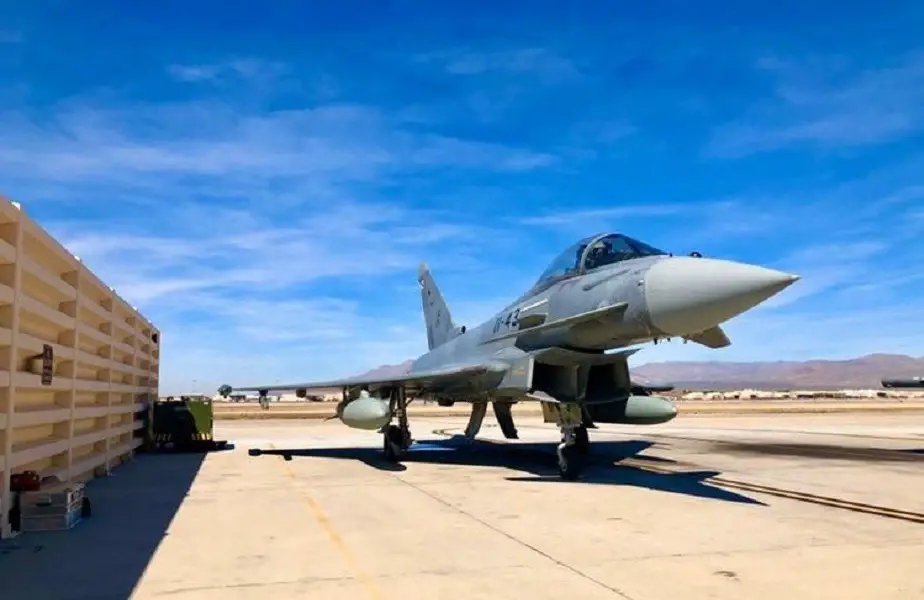Aircraft representing the air forces of more than 10 countries took part in the Red Flag combat training exercise at Nellis Air Force Base in Nevada, US between 8 and 20 March.
Follow Air Recognition on Google News at this link
 24 Eurofighters took part in the exercise (Picture source: Airbus)
24 Eurofighters took part in the exercise (Picture source: Airbus)
Red Flag is the world’s most important air combat training exercise. Established in 1975, Red Flag is held between four and six times per year in the Nevada desert in the US, sometimes with the participation of foreign air forces.
A typical RED FLAG exercise involves a variety of attack, fighter and bomber aircraft (F-15E, F-35, F-16, F/A-18, A-10C, B-1B, B-2A, B-52H, FGR4, MQ-9, etc.), reconnaissance aircraft (MQ-4B, RC-135, U-2S), electronic warfare aircraft (EC-130H, EA-18G and F-16CM), air superiority aircraft (F-22A, F-15C, etc), airlift support (C-130, C-17A), Search and Rescue aircraft (HH-60G, HC-130J, CH-47), aerial refueling aircraft (KC-130, KC-135R, KC-10A, etc), multi-domain Command and Control platforms (E-3, E-8C, E-2C, E-7, R1, etc) as well as ground based Command and Control, Space, and Cyber Forces.
Together with the US as host nation, NATO partners such as Germany, Italy and Spain perform realistic combat exercises in the air, on the ground and in cyberspace. Bombers carry out low-altitude air strikes on simulated positions, vehicle convoys and mock airfields, which are armed with military equipment to create a realistic scenario. Early-warning and target acquisition radar, as well as electronic countermeasures (jammers), make the training environment as true to life as possible.
The ‘Blue’ forces of the NATO partner nations fly missions against the ‘Red’ forces, a simulated enemy.
The test and training range at Nellis Air Force Base in Nevada measures around 270 km by 90 km, providing unique training conditions for multinational pilots.
The German, Italian and Spanish Eurofighters involved flew almost around the clock, completing missions in two shifts and conducting a total of 20 exercises. These challenging missions simulated combat in the air, on the ground and in cyberspace. The Eurofighters flew together with other combat aircraft such as the Tornado, F-35A and F-16, and completed their tasks to the satisfaction of those directing the exercise.
Planning for the German Eurofighters’ participation in the event had already begun one year earlier. The units started filling the first containers with materials back in November 2019. Ships and cargo aircraft transported just under 150 containers to the US. “During the journey, the Eurofighters were refuelled in mid-air by A330 MRTTs from the Royal Air Force and A310 MRTTs from the German Air Force, meaning they only had one stopover,” explains Marco Gumbrecht, Head of Eurofighter Future Business Germany and Head of Military Relations Combat Aircraft Systems – a former Eurofighter pilot himself. “MRTTs can be used for transport as well as refuelling purposes, which meant the number of additional transport aircraft required could be reduced. This made the plan for getting the Eurofighters to the US much easier.”
t’s no coincidence that the Eurofighters performed so well: the air forces started practising their approach and take-off manoeuvres at Nellis Air Force Base long before the exercise began; that way, they could familiarise themselves with the Red Flag scenarios and quickly adjust to the new conditions.
“The German Air Force in particular has been a pioneer with its Mission Readiness Training,” says Marco. “Our Airbus colleagues and experts from the German Air Force adopted a flexible and agile approach in coordinating these preparations, and the training sessions in our Airbus simulators allowed us to realistically reproduce the scenarios.”
The Spanish Air Force was also ready for the exercise: “The flying wings units prepared by selecting and suiting up the aircraft beforehand,” explains Squadron Leader David Neira, Eurofighter pilot and Commander of 111th Squadron. “Some two months before relocating to the US, we performed specific training for the aircrews. This training plan for the pilots included hundreds of flying missions in different roles. Furthermore, we conducted important simulator training at our ASTA [Aircrew Synthetic Training Aids] here in Morón, as well as other activities like sea survival training or medical check-ups.”
The days in Nellis were long for the entire team. Preparations for a single mission took up to 10 hours – with two exercise phases per day. “A Red Flag exercise is typically divided into two shifts: day and night,” says David. “The day shift starts at 10 a.m. and the night shift at 6 p.m. The routine is to plan the mission the day beforehand and execute it the following day.”
Most missions flown involve the ‘Blue’ forces of NATO partners engaging the ‘Red’ forces, an advancing, simulated enemy, in what are known as offensive counter air operations. The aggressors are specially trained to replicate the tactics and techniques of potential adversaries and provide a scalable threat presentation to Blue forces which aids in achieving the desired learning outcomes for each mission. The Eurofighters took on several roles here: with their 500-kilogram GBU-48 bombs and cannons, they can be deployed against ground targets – during close air support or against high-value enemy targets, for example to destroy fuel storage facilities on the ground. At the same time, the Eurofighters can also adopt an air-to-air role against hostile aircraft to fight their way into a target area or support other important allies. The Eurofighters performed all of their manoeuvres excellently.
The exercise had to finish earlier than planned due to the spread of the coronavirus. Participants and materials from the event were quickly taken back home by Airbus A400Ms and a number of government aircraft from the German Federal Ministry of Defence. The Eurofighters were also able to return quickly thanks to additional fuel tanks, stopovers in the US and air-to-air refuelling by the US Air Force.
















